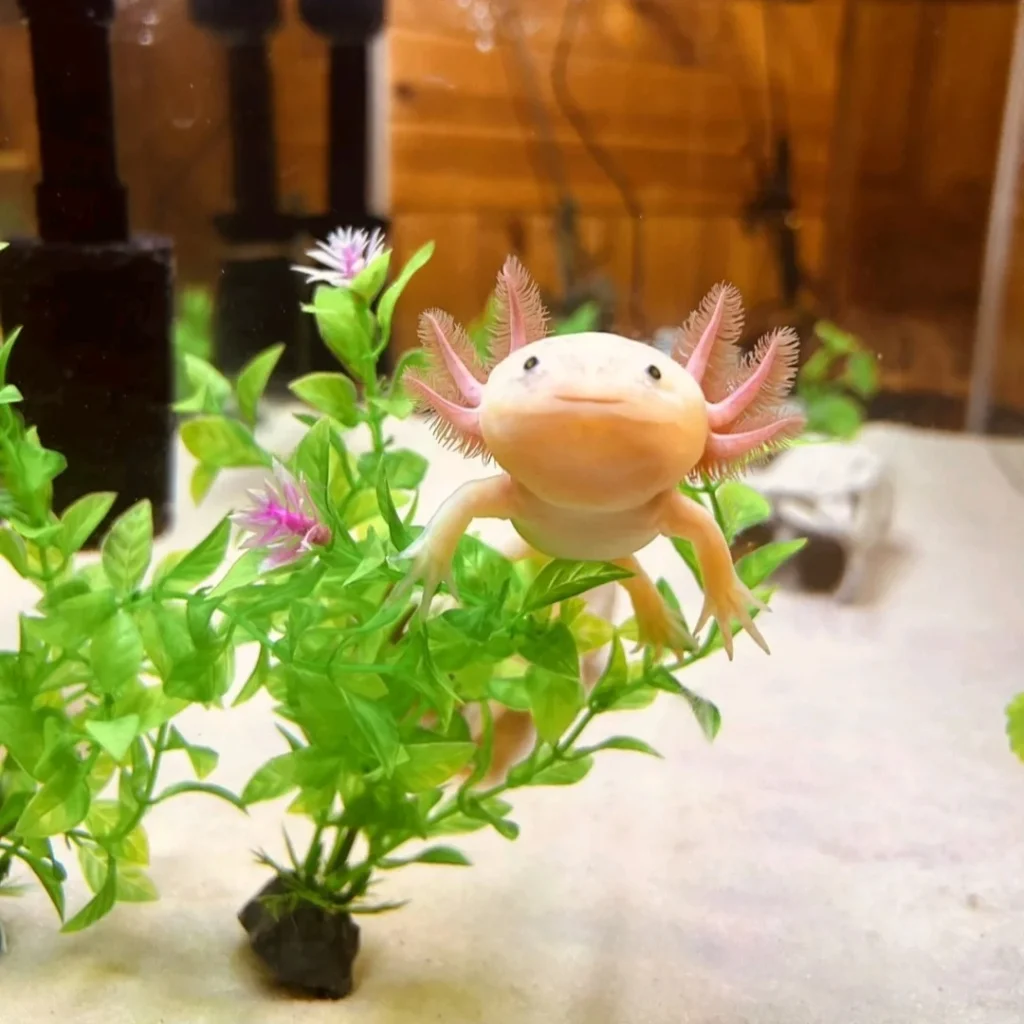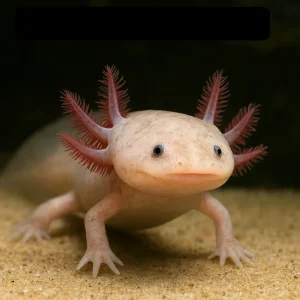What Is an Axolotl?

Axolotls (Ambystoma mexicanum) aren’t fish, despite the “Mexican walking fish” nickname floating around pet stores. They’re neotenic salamanders—which is a fancy way of saying they hit pause on growing up and stay in their larval, water-breathing form for life.
Most salamanders lose their gills, develop lungs, and crawl onto land as adults. Axolotls? They keep those feathery external gills, retain their dorsal fin, and remain fully aquatic from egg to elderly. It’s Peter Pan syndrome, but make it amphibian.
What makes them scientifically mind-blowing—and honestly, a little unnerving—is their regenerative capacity. They don’t just heal wounds. They rebuild entire limbs, chunks of spinal cord, heart tissue, even portions of their brain, all without scar tissue (Faisal et al., 2024).
- External gills: Trademark feathery gills on either side of the head
- Regeneration: Can regrow limbs, spinal cord, even heart and brain tissue without scarring—usually in 4–8 weeks
- In the wild: Found only in Lake Xochimilco, Mexico City, and critically endangered due to habitat destruction and pollution (likely <1,200 remain)
Quick Start Card
- Tank Size: 29–40+ gallons minimum (long footprint, not tall)
- Water Temperature: 59–68°F (15–20°C)—never exceed 68°F consistently
- Primary Diet: Earthworms, high-quality sinking pellets (≥45% protein)
- Lifespan: 10–15 years with proper care; some reach 20+
- Handling: Avoid entirely unless emergency; their skin is absorbent and fragile
- Legal Status (U.S., 2025): Illegal in California, Maine, New Jersey, Washington D.C.; permits required in Hawaii, New Mexico; registration needed in Arkansas
Is It Legal in Your State? (2025 U.S. Law Update)
Before you fall in love with a morph on some breeder’s Instagram, check your local laws.
Illegal to own in:
- California
- Maine
- New Jersey
- Washington D.C.
Penalties range from fines to confiscation to criminal charges. California, in particular, takes exotic pet enforcement seriously.
Permits or registration required in:
- Hawaii (permit needed)
- New Mexico (permit needed)
- Arkansas (owner registration required)
Even if your state is “legal,” some counties and cities have their own restrictions. Always verify with your local wildlife or exotic pet agency. And when you buy from a breeder, get documentation—lineage, health records, proof of legal sale. You may need it later for vet visits, moves, or resale.
What is the real cost of its ownership?
Axolotls aren’t goldfish. The upfront and recurring costs are real, and pretending otherwise sets you up for failure.
Initial Investment:
- Axolotl purchase: $60–$80 (common morphs like wild-type, leucistic); $200–$400+ (rare morphs like copper, mosaic, heavily marked melanoid)
- Tank setup: $300–$700 (tank, filter, chiller or cooling fans, hides, substrate if using sand, water test kits, thermometer, dechlorinator, decorations)
Monthly Recurring:
- Food: $10–$25 (earthworms, pellets, occasional treats)
- Water conditioner & test kits: $5–$10
- Electricity (filter, chiller, fans): $10–$20 depending on your cooling method
Emergency Veterinary:
Exotic vets aren’t cheap, and amphibian specialists are rare. A single health crisis—impaction, severe fungal infection, buoyancy disorder—can easily run $200–$600+. Identify an experienced exotic vet before you need one, not during a 2 a.m. panic.
How to build the right environment in the axolotl tank?
Recommended Tank Size:
Pick a tank that prioritizes horizontal space. A 29-gallon long is the absolute bare minimum for one axolotl. A 40-gallon breeder is better. If you’re ever considering multiple axolotls (not recommended, but we’ll get to that), plan for 50–60+ gallons total.
Why so much space required for it?
Axolotls have a massive bioload. They produce significant waste, which converts to nitrate, and nitrate buildup is one of the fastest routes to stress and disease. Larger water volumes dilute toxins and give you breathing room between water changes (Ochoa & Mickle, 2024).
Taller tanks might look impressive, but axolotls don’t swim vertically. They walk along the bottom, cruise slowly, and explore horizontally. A tall, narrow tank cramps their movement and makes parameter stability harder to maintain.
Axolotl Tank Requirement???
Substrate Safety: Preventing Deadly Impaction
This is where a lot of new keepers screw up. Axolotls are opportunistic feeders with terrible aim. They gulp at food, suck up substrate, and sometimes swallow things they shouldn’t.
Safe Substrate Options
- Bare-bottom tank: Safest, easiest to clean, zero impaction risk. The downside? It can be slippery, and some axolotls struggle with grip.
- Fine sand (<1 mm grain size): Safe for axolotls over 6 inches long. If swallowed, it passes through their digestive system without causing blockages. Never use sand with juveniles under 15 cm (6 inches)—they’re too small for even fine particles to pass safely (Ochoa & Mickle, 2024).
- Large slate tiles or smooth river rocks (larger than their head): Aesthetic, easy to clean, no ingestion risk.
What to Never Use
- Gravel (any particle >2 mm diameter)
- Small decorative pebbles
- Aquarium marbles
Impaction—when substrate blocks the digestive tract—is one of the most common causes of death in captive axolotls. Symptoms include bloating, constipation, floating, and refusal to eat. By the time it’s obvious, it’s often too late (Swell Reptiles, 2024).
Filtration: Gentle Flow, Maximum Efficiency
Axolotls need clean water, but they hate strong currents. Their gills are delicate, and turbulent flow causes stress, gill damage, and exhaustion.
Best Filter Types
- Sponge filters with air pumps: Gentlest option, perfect for juveniles and sensitive adults
- Hang-on-back (HOB) filters with baffled output: Use a spray bar or sponge to diffuse the flow
- Canister filters with outflow aimed at glass or baffled: High filtration capacity, but requires modification to reduce current
Aim for a filter rated for 3–4× your tank volume per hour, but always baffle or redirect the output. Strong jets will stress your axolotl and damage their gills over time (API Fish Care, 2024).
Don’t Forget the Lid
And use a lid. Axolotls jump. Not often, but when they do, it’s catastrophic if the tank is uncovered.
Temperature Control: The Non-Negotiable Challenge
This is the dealbreaker for most people. Axolotls are cold-water amphibians. They thrive in 59–68°F (15–20°C), with the lower end of that range being safest for long-term health. Anything consistently above 68°F (20°C) causes stress, immune suppression, and disease susceptibility. Above 75°F (24°C), you’re looking at organ failure (Axolotl Nerd, 2022; Fantaxies, 2023).
Room temperature feels fine to humans. It’s deadly to axolotls.
Why Temperature Matters So Much
Because axolotls are ectothermic (cold-blooded), their body temperature matches the water. They don’t sense gradual temperature increases until it’s too late—they’ll just slow down, stop eating, and decline (Fantaxies, 2023).
Cooling Solutions:
- Aquarium chiller ($300–$800): Most reliable. Set it and forget it. Essential for warm climates.
- Room air conditioning: Keeps the entire space cool. Most cost-effective long-term if you already have AC.
- Clip-on fans (2–3 aimed at water surface): Uses evaporative cooling. Can drop temps 2–4°F, but requires monitoring.
- Frozen water bottles: Emergency use only. Causes temperature swings, which stress axolotls.
- Ice packs in filter chamber: Temporary. Same problem as bottles—unstable temps.
If you live somewhere hot and don’t have a cooling plan, don’t get an axolotl. Fans and frozen bottles aren’t sustainable for months of summer heat.
Cycling Your Tank: The 4–8 Week Wait You Can’t Skip
Never—and I mean never—add an axolotl to an uncycled tank. The nitrogen cycle must be fully established first, or you’re sentencing your axolotl to ammonia poisoning, gill burns, and fungal infections.
The Nitrogen Cycle Explained
- Fish waste, uneaten food, decaying matter release ammonia (NH₃/NH₄⁺)—highly toxic
- Beneficial bacteria (Nitrosomonas) convert ammonia into nitrite (NO₂⁻)—also toxic
- Different bacteria (Nitrobacter) convert nitrite into nitrate (NO₃⁻)—less toxic, but still harmful in high concentrations
A fully cycled tank has 0 ppm ammonia, 0 ppm nitrite, and detectable nitrate (5–20 ppm is ideal). This process takes 4–8 weeks without seeded media (Ochoa & Mickle, 2024).
How to Cycle Your Tank
- Set up tank with filter running
- Add ammonia source (pure ammonia drops or fish food method)
- Test water every 2–3 days
- Watch for ammonia spike → nitrite spike → nitrate rise
- When ammonia and nitrite stay at 0 for a week straight, you’re cycled
Target Water Parameters (Post-Cycle)
- Ammonia: 0 ppm (can tolerate 0.25 ppm briefly in emergencies)
- Nitrite: 0 ppm (can tolerate 0.5 ppm short-term)
- Nitrate: 0–20 ppm ideal; <40 ppm tolerable with frequent water changes
- pH: 6.5–8.0 (7.4–7.6 optimal for long-term stability)
- General Hardness (GH): 7–14°dH (125–250 ppm)
- Carbonate Hardness (KH): 3–7°dH (53–125 ppm)
Use liquid test kits—API Freshwater Master Test Kit is the gold standard. Test strips are too imprecise and miss critical readings (Water Critters, 2024).
BehaFoods to Never Feed
vior & Temperament (Observation, Handling, Cannibalism)
- Personality: Solitary, watchful, mostly sedentary
- Handling: Avoid except for emergencies—skin & gills are very sensitive
- Aggression: Juveniles are cannibalistic; adults may injure tankmates if crowded
Is It Legal in Your State? (2025 U.S. Law Update)
- Illegal: California, Maine, New Jersey, and Washington D.C.—fines, confiscations, and severe penalties
- Permits Needed: Hawaii, New Mexico
- Registration: Arkansas—owner registration required by law.
- Check your state’s wildlife or exotic pet regulations before obtaining an axolotl and keep documentation on hand.
Cost of Ownership (Realistic U.S. Budget)
- Purchase price: $60–$80 (common types); $200–$400+ (rare color morphs)
- Initial tank setup: $300–$700 (tank, chiller/fan, strong filter, test kits, hides, sand, thermometer, conditioner, decorations)
- Recurring costs: $10–$40/month (food, water conditioners, testing materials, electricity)
- Emergency/vet care: Can be significant—find a local exotics vet before you need one
Tank Setup Step-by-Step (With Safe Water Parameters)
Recommended Tank Size & Shape
Prefer 29–40+ gallons per axolotl, long-style tanks for more floor space (not tall or bowl-shaped!). Roomy tanks promote stable water quality and reduce stress/aggression as they age.
Substrate Choices
- Bare-bottom: Safest for beginners—easy waste removal, zero impaction risk.
- Sand (fine, <1mm): Best for axolotls over 6” long—provides traction and is passable if swallowed (never use gravel or pebbles, which can cause fatal impaction).
- Slate tiles: Some keepers use these for grip, safety, and easy cleaning.
Filtration & Flow (Best Options in 2025)
- Gentle filtration: Sponge filters or well-baffled hang-on-back/canister filters; axolotls dislike strong currents, so always break up/baffle the outflow.
- Always use a lid—axolotls can and do jump!
Temperature Control
- Keep water always between 59–68 °F (15–20 °C). Lower end (60–65 °F) is safest for long-term health; never let water exceed 68 °F.
- Use fans, chillers, room A/C, or frozen bottles for cooling in hot weather.
- No heaters—axolotls are cold-water amphibians and overheat easily.
Cycling Your Aquarium (Water Chemistry Essentials)
- Cycle tank for 4–8 weeks before adding your axolotl—allows beneficial bacteria to convert toxic ammonia (NH₃/NH₄⁺) into nitrite (NO₂⁻), and then into relatively safe nitrate (NO₃⁻).
- Target water parameters:
- Ammonia: 0 ppm
- Nitrite: 0 ppm
- Nitrate: <20 ppm (40 ppm max, but best ≤20)
- pH: 6.5–8.0, ideal 7.4–7.6
- Weekly water testing is absolutely essential—use liquid tests, not strips, for accuracy.
Decor & Enrichment
- Provide at least 2–3 hides (PVC, ceramic caves, flowerpots)
- Safe live plants: Anubias, Java fern, Java moss—also help absorb nitrate
- Minimal, dim lighting (axolotls have no eyelids and are light-sensitive)
- Rearranging decor every month provides natural “enrichment”
Weekly Maintenance
- Replace 20–30% of tank water with dechlorinated, temp-matched water weekly
- Daily: remove uneaten food or waste using a siphon/turkey baster
- Clean filter media in tank water only (never tap)
Feeding Axolotls the Right Way
Staple Diet
- Best main food: Earthworms/nightcrawlers (robust protein, calcium, and perfect Ca:P ratio)
- Secondary: Sinking axolotl/carnivore pellets (Hikari, Northfin, etc., 45% protein or higher)
- Treats: Bloodworms, blackworms, brine shrimp, Repashy gel food, soft chopped white worms
Feeding Schedule by Age/Size
- Hatchlings (<2 in): 2–4× per day (baby brine shrimp/daphnia)
- Juveniles (2–6 in): Every other day or daily; chopped worms and pellets
- Subadults/adults (>6 in): 2–3× per week (1–2 large worms or equivalent in pellets)
- Moderator note: Adult axolotls can be overfed (obesity causes health issues)—belly should be gently rounded, not bloated.
Treats vs. “Do-Not-Feed”
- Safe treats: Bloodworms, blackworms (occasionally, not as staples), ghost shrimp (must quarantine)
- Never feed: Goldfish, feeder fish (parasites, thiaminase), raw meat/poultry, live insects (unless diet-approved), fatty foods
Feeding Technique & Hygiene
- Always use feeding tongs or forceps for precision; it keeps food out of the substrate.
- Remove uneaten food after 10–15 minutes to prevent water fouling
- Pause filter during feeding to avoid food flying everywhere
Health & Troubleshooting
Normal vs Abnormal Behaviors
- Normal: Resting on the bottom, slowly exploring, “firing up” (gills turn bright, body darkens with excitement)
- Abnormal: Floating, darting, excessive hiding, refusal to eat, shrunken gills, curled tail tip—immediate water testing required
Water-Quality Issues
- Most illnesses arise from water problems (NH₃, NO₂⁻, NO₃⁻, temp).
- Symptoms: Lethargy, fungus, gill damage, floating—immediately start partial water changes and correct parameters
Common Conditions
- Impaction: Most commonly from ingesting gravel. Floaty, off food, distended—remove substrate and consult a vet.
- Fungal infections: White, cottony growths—urgent care needed; consult vet for salt bath/medical treatment.
- Gill loss, ulcers: Primarily water/temperature stress or tankmate nipping
When to Call an Exotics Vet
Not eating for one week, persistent floating/listing, ulcers, loss of body parts not regenerating, red/inflamed gills
Tankmates & Cohabitation (Cautions in 2025)
Why Solo Is Safest
- Axolotls are naturally solitary and happiest alone.
- Groups are only possible in ultra-large, meticulously maintained tanks, with individuals of similar size and ample hides. Even then, nipping and separation are common.
Shrimp as Cleanup/Enrichment
Ghost or cherry shrimp may be used as scavengers—but quarantine >30 days first. Many will get eaten and shouldn’t be a staple.
Juvenile Cannibalism & Breeding Risks
- Juvenile and subadult axolotls are highly cannibalistic; only house together if same size and very well-fed.
- Breeding requires major prep—females may lay hundreds of eggs, and adults often eat the spawn if left in the tank.
- Axolotl Pet Guide 2025: Ultimate Care, Setup & Health
 This science-backed 2025 axolotl pet guide covers biology, tank setup, diet, health, costs, morphs, and expert care tips for everyone.
This science-backed 2025 axolotl pet guide covers biology, tank setup, diet, health, costs, morphs, and expert care tips for everyone.
Q: What temperature is best?
A: 59–68 °F (15–20 °C); avoid >68 °F.
Q: How big should my tank be?
A: At least 29 gallons+; long tanks are best.
Q: Can I keep fish with axolotls?
A: No—risk of nipping, eating, and stress.
Q: How often do I feed my axolotl?
A: Hatchlings daily, adults 2–3× per week.
Q: Do axolotls eat plants?
A: No; strict carnivores.
Q: Is it safe to pick up my axolotl?
A: Only if absolutely necessary; use wet hands or a soft net.
